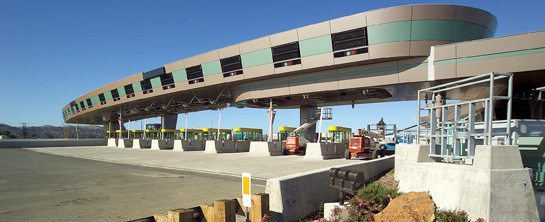Crews are now putting the finishing touches on the second span of the Benicia-Martinez Bridge — the Bay Area’s newest bridge — in preparation for its opening later this year.

The futuristic toll plaza of the new Benicia-Martinez bridge is designed for open-road tolling, allowing motorists with FasTrak® toll tags to pass through the far left lanes at highway speeds. Photo by John Huseby, Caltrans
By Karin Betts
Published: February, 2007
The span will carry five lanes of northbound traffic from Contra Costa County to Solano County, nearly doubling the capacity of Interstate 680 over the Carquinez Strait. The existing bridge will be converted to four lanes of southbound traffic with a two-way bicycle/pedestrian lane, another link in the growing Bay Trail recreational corridor. Soon rush-hour traffic jams along this section of freeway will be a thing of the past.
The new bridge makes a graceful curve across the Strait, east of both the existing span and the Union Pacific railroad bridge and overlooking Suisun Bay and the ghost fleet of decommissioned Navy ships. The $1.26-billion project includes the new main span and a new toll plaza plus reconstruction of the Interstate 680 interchanges at Interstate 780 in Benicia and Marina Vista/Waterfront Road in Martinez to accommodate the new bridge. Remaining work includes installing the bridge’s railing and electrical fixtures and grinding the concrete deck to create a long-lasting non-skid driving surface, as well as modifications to the new toll plaza.
The opening of the bridge and toll plaza later this year will mark the Bay Area debut of open-road tolling, which allows vehicles equipped with FasTrak® electronic toll tags to bypass the booths and cross the span without slowing down. Open-road tolling is part of moving toll collection out of the 20th Century and into the 21st, stated Rod McMillan, who oversees bridge operations for BATA, the Bay Area Toll Authority. BATA funds the day-to-day operations, facilities maintenance and administration of the Bay Area’s bridges with moneys levied from tolls, and is run by the Metropolitan Transportation Commission. BATA also is responsible for the oversight of the Benicia-Martinez Bridge construction.
The new span is a box girder bridge made up of strong yet lightweight concrete boxes linked together by steel and concrete, and supported by pier columns. It is possible for Caltrans workers to go into the bridge’s interior — where the ceiling is 40 feet tall at its highest point and 15 feet at the lowest — to do maintenance work.
At the height of construction, 250-300 workers labored daily on the span. Unlike the new East Span of the San Francisco-Oakland Bay Bridge, which utilizes pre-cast deck segments that were lifted to roadway level, the deck of the Benicia-Martinez Bridge was cast in place in 15-foot-wide segments, creating the illusion that the new bridge materialized slowly out of thin air. Like branches growing horizontally from a tree trunk, each of the bridge’s 17 columns sprouted balanced deck segments that grew toward their neighboring column until all 344 segments were cast. The last step, completed in December 2006, involved connecting these branches via concrete pours to create a sleek, continuous deck.
A frustrating series of challenges and setbacks raised the original cost of the new span and delayed its completion. After the initial plans were drawn in late 1990s, the bridge location was moved further to the east side of the existing span, necessitating changes to the design and delaying the start of construction. Then, when pile driving began, environmental advocates voiced concern that the vibrations in the water were hurting migrating fish, prompting Caltrans to develop an innovative bubble curtain to absorb sound waves during pile driving and foundation work. Caltrans also had to engineer a new way of installing the bridge’s foundations due to unanticipated weaknesses in the Bay floor.
The major culprit in the third wave of cost increases was the lightweight concrete used on the span. The mix of concrete and aggregate heated to unexpectedly high temperatures after it was poured — over 192 degrees instead of below 160 degrees — and had to be cooled to prevent cracks later in life. The contractor essentially refrigerated the concrete by adding ice to the mix and installing cooling tubes to pump cold water through the concrete as it hardened.
The general notion is that a concrete roadway is the most straightforward type of bridge to build, but it didn’t work out that way with Benicia-Martinez, explains Andrew Fremier, deputy executive director of the Bay Area Toll Authority. But I’m fond of this bridge nonetheless; the technical challenges that it presented were humbling.
Key to goods movement in the region, the existing Benicia-Martinez Bridge provides a connection between the Sacramento Valley and cities of central Contra Costa County, southern Alameda County and San Jose. It now carries over 18 million motorists a year, or 100,000 vehicle crossings (both directions) on a typical day, making it the third most heavily used bridge in the Bay Area after the San Francisco-Oakland Bay Bridge and the Carquinez Bridge.
The 1988 voter-approved Regional Measure 1 (RM 1) Toll Bridge Capital Improvement Program — which raised bridge tolls in the Bay Area to a uniform $1 — funded construction of the new span. Managed by MTC’s Bay Area Toll Authority, RM 1 has delivered many projects used daily by Bay Area drivers, including the new Al Zampa Memorial (Carquinez) Bridge, a widened San Mateo-Hayward Bridge and a major rehabilitation of the Richmond-San Rafael Bridge. Remaining projects in the RM 1 program include the demolition of the 1927 Carquinez Bridge (scheduled for completion in 2007) and reconstruction of the Interstate 880/State Route 92 interchange (scheduled to open to traffic in 2011).


The sleek, 1.7-mile-long new structure — a technical challenge to build — will carry northbound vehicles on Interstate 680 when it opens later this year. Photos by John Huseby, Caltrans

